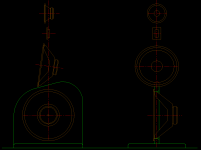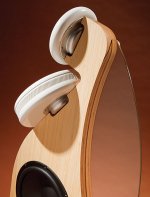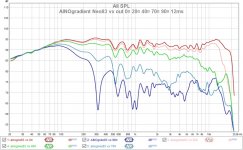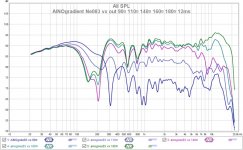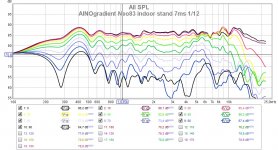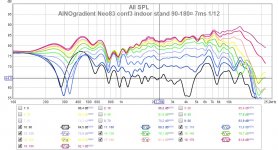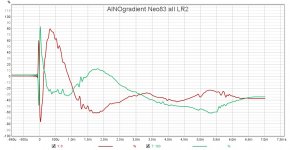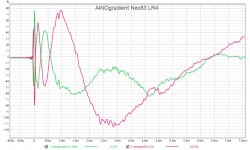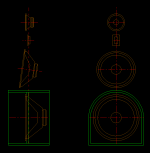This is fun!
I drafted a quick 4-way solution with the same drivers as before, GW-1858, Deltalite II 2515, SB17CAC35-4 and AST2560.
I had to place the SB17 above the tweeter to keep this one at a height of 40".
The baffle holding the GW-1858 is 1.5" thick.
Not shown is the 4 post structure from which the nude drivers are suspended.
I drafted a quick 4-way solution with the same drivers as before, GW-1858, Deltalite II 2515, SB17CAC35-4 and AST2560.
I had to place the SB17 above the tweeter to keep this one at a height of 40".
The baffle holding the GW-1858 is 1.5" thick.
Not shown is the 4 post structure from which the nude drivers are suspended.
Attachments
Getting back to your question, with crossover points like 80Hz or 100Hz, where the wavelength is around 4.3m and 3.4m, you can have an offset of several centimeters and it will be OK. For example, 36 degrees equates to 40cm at 80Hz, and 34cm at 100Hz.
In the draft design above, I estimated the acoustic centers and manage to line them all up, but only by putting the SB17CAC above the tweeter.
Why orientate the woofer like that? The null is pointing towards you.
I was just trying to see if the configuration shown in the commercially available speakers in post #113 could made to work with the drivers I plan on using AND keep the tweeter between 38" and 40" off the ground.
@iamvalheru, Juhazi, etc.
I have always looked at that design with the woofer rotated so that the 90degree null points at the listener with surprise. I suppose this is an example of how important the "room sound" is, because that is probably what is dominating (over the direct sound) assuming the 90 degree off axis null is 20dB deep. Why do that?
I faintly recall that when I brought this point up before (several years ago?) someone had a model that explained how the room would fill in the bass. I think that in the model the speakers were located at 1/3 and 2/3 of the way across the room and near the front wall... can anyone fill in the blanks on that?
I have always looked at that design with the woofer rotated so that the 90degree null points at the listener with surprise. I suppose this is an example of how important the "room sound" is, because that is probably what is dominating (over the direct sound) assuming the 90 degree off axis null is 20dB deep. Why do that?
I faintly recall that when I brought this point up before (several years ago?) someone had a model that explained how the room would fill in the bass. I think that in the model the speakers were located at 1/3 and 2/3 of the way across the room and near the front wall... can anyone fill in the blanks on that?
If you want to save a few vertical inches, you can reverse the orientation of the woofer (lowest band driver) by 180deg so that from the listening location you are looking at the magnet. Then you overlap the mounting flange of that driver with the driver in the next higher band. This works because, for low frequencies, the output from a woofer is symmetrical, e.g. essentially a true dipole. So you can use the driver either way up to 300Hz or so.
As someone who has built and sold quite a few speakers, I have to say that there is also the aesthetic aspect consideration in a commercial design.
Compromises are made, you have to sell speakers. Turning the baffle and extending it with glass allows for a very wide baffle to support the low end capabilities, while giving a dead sexy narrow front profile that the wife will allow in the room, without forcing the buyer to sleep in there with it.
And cost is a thing too. A very important thing if you want to stay in business. If that mid was a true dipole, it could never reach down low enough to cross with that woofer at a frequency that would not have major beaming in the woofer.
And if you don't have a room where you can keep a full dipole speaker well away from the back wall, the mid-highs can get very hot off the wall behind. As an aside, the depth of that baffle actually means they can't shove it right up the wall also, and that will sound better in and of itself regardless of design.
For the same reason Linkwitz blocked the output directly to the rear on the last iteration of the pluto, with foam inside the pipe...trust me, if you did not do that and it was close to the back wall in a small room, the reflection would be very noticeable.
Also the reason you can't make an omni pointing even a small full range speaker upwards; the beaming will make it seem like it's coming off the ceiling. Only the woofer can be used that way, and it has to be crossed low. Even a 3 inch starts to become directional around 1500hz, and as it transitions to half space radiation can start to get in your face around 3000 with the gain...just like baffle step, people tend to look at it like it's a loss, but what's really happening is the driver is gaining, and getting louder as it starts to beam, and the cone is not acting like a piston anymore, but breaking up into modes.
If you truly want a dipole radiation pattern as high as you can go, you have to use driver sizes that avoid beaming, and that starts when the driver is a third of the wavelength it's producing. You can go between an half octave to an octave above that, any more than this and you're compromising constant directivity.
Compromises are made, you have to sell speakers. Turning the baffle and extending it with glass allows for a very wide baffle to support the low end capabilities, while giving a dead sexy narrow front profile that the wife will allow in the room, without forcing the buyer to sleep in there with it.
And cost is a thing too. A very important thing if you want to stay in business. If that mid was a true dipole, it could never reach down low enough to cross with that woofer at a frequency that would not have major beaming in the woofer.
And if you don't have a room where you can keep a full dipole speaker well away from the back wall, the mid-highs can get very hot off the wall behind. As an aside, the depth of that baffle actually means they can't shove it right up the wall also, and that will sound better in and of itself regardless of design.
For the same reason Linkwitz blocked the output directly to the rear on the last iteration of the pluto, with foam inside the pipe...trust me, if you did not do that and it was close to the back wall in a small room, the reflection would be very noticeable.
Also the reason you can't make an omni pointing even a small full range speaker upwards; the beaming will make it seem like it's coming off the ceiling. Only the woofer can be used that way, and it has to be crossed low. Even a 3 inch starts to become directional around 1500hz, and as it transitions to half space radiation can start to get in your face around 3000 with the gain...just like baffle step, people tend to look at it like it's a loss, but what's really happening is the driver is gaining, and getting louder as it starts to beam, and the cone is not acting like a piston anymore, but breaking up into modes.
If you truly want a dipole radiation pattern as high as you can go, you have to use driver sizes that avoid beaming, and that starts when the driver is a third of the wavelength it's producing. You can go between an half octave to an octave above that, any more than this and you're compromising constant directivity.
Yes probably, I'm referring to edge diffraction having the same effect as a very early reflection and blurring the image.
I agree with Charlie on minimum baffle diffraction, and would only add that there's a transition point at a frequency relative to the size of the driver/baffle.
The frequency that a driver begins to become directional and start beaming, which is when it equals a third of the wavelength it is producing.
Take a 4" driver that begins to become directional at 1127hz or so, crossed to an 8" mid at 1000hz.
Dipole diffraction/cancellation effects are actually much worse than a baffle of the same width in a closed box. With the 4" we expect a null and then a hump below it when the front and back come back into phase with each other before entering pure dipole cancellation.
But because the driver is becoming directional we do not see as deep a null as we expect, because not enough energy is reach the edge.
But we do see the half wavelength hump where they add, right about when the driver is becoming omnidirectional and radiating into full space at 1127, or thereabouts. Personally I deal with this in the crossover, as it is close to the crossover frequency.
I like to say the 8inch is running off the baffle, because nude or with minimal baffle it is operating entirely below the point where it is omnidirectional, and the compression wave in the front is completely cancelled when it meets the rarefaction from the rear. There are no diffractive effects.
Even though dipole effects are magnified diffractive effects, they are minimalized strategically with driver/baffle sizes and crossover points. Only the lower registers of the 4 inch will experience regular diffractive effects before it becomes too directional and does not illuminate the edge at all, and as Charlie points out, these effects have been driven as high in frequency as possible...pretty much completely eliminated with careful design.
Gradient Helsinki 1.5 is controversial with the sideways bass dipole. The cookie cardioid midrange in itself works quite well I understand, and matches the waveguide tweeter's dispersion. I have never heard it playing.
There are some articles about 1.5 and making it sound good in a room is not easy. I don't like the idea at all. Dpiole front and backwave are supposed to hit the nearby walls and fill the room with bass without localization (below Schröder). Crossover to mid is around 250Hz.
Gradient Helsinki 1.5 loudspeaker | Stereophile.com
"When I first set up the Gradient Helsinkis, with only a small amount of toe-in, the low frequencies sounded rather phasey. This was minimized by increasing the toe-in angle to 45°. Once the speakers had been moved next to the sidewalls, I was reminded that there is something very attractive about the sound of low frequencies produced by an aperiodic design—as I had found with the Gradient Revolution, which also has a dipole-mounted 12" woofer. "
With Gradient Revolution, the user can rotate the bass module in relation to mid-tweeter top. And yes, Atkinson got better room response with Revolution than with Helsinki!
Gradient Revolution loudspeaker | Stereophile.com
There are some articles about 1.5 and making it sound good in a room is not easy. I don't like the idea at all. Dpiole front and backwave are supposed to hit the nearby walls and fill the room with bass without localization (below Schröder). Crossover to mid is around 250Hz.
Gradient Helsinki 1.5 loudspeaker | Stereophile.com
"When I first set up the Gradient Helsinkis, with only a small amount of toe-in, the low frequencies sounded rather phasey. This was minimized by increasing the toe-in angle to 45°. Once the speakers had been moved next to the sidewalls, I was reminded that there is something very attractive about the sound of low frequencies produced by an aperiodic design—as I had found with the Gradient Revolution, which also has a dipole-mounted 12" woofer. "
With Gradient Revolution, the user can rotate the bass module in relation to mid-tweeter top. And yes, Atkinson got better room response with Revolution than with Helsinki!
Gradient Revolution loudspeaker | Stereophile.com
About timing and aligning acoustic centers - with multiway dipoles it is almost impossible to get perfect match at 0 and 180deg. It can be done with planars, but harly with cones or mixing cones and planars.
I searched my measurements of AINOgradient and studied them with different time windows, but various reflections and differences in dsp settings make analysis tricky. Anyway, I decided to optimize frontal response in matching 12" low mid cone and planar upper mid around 600-800Hz. LR4 slopes give prettier measurements but still I prefer the sound of LR2. Perhas because of less group delay ove xo and smoother vertical response...
Here some in- and outdoor measurements - more in the thread found in my signature.
I searched my measurements of AINOgradient and studied them with different time windows, but various reflections and differences in dsp settings make analysis tricky. Anyway, I decided to optimize frontal response in matching 12" low mid cone and planar upper mid around 600-800Hz. LR4 slopes give prettier measurements but still I prefer the sound of LR2. Perhas because of less group delay ove xo and smoother vertical response...
Here some in- and outdoor measurements - more in the thread found in my signature.
Attachments
And step responses 0 and 180 for LR2 and LR4 crossovers. Notice the 180deg irregularities and bend in step at cardioid response. Backside responses green. Same measurement series as in previous post.
Attachments
So, for a 4-way dipole, LR2 is preferable for all drivers, but what about BW3?
Also, if typical listening off axis angle in 15-30 degrees, try to optimize in that region?
No rules! With DIY you are free to try everything, just try to understand what and why you do, and learn more from experiments. I think measurements are most important, but when all basics are in good form, final touches in sound are subjective. And there is always something left to make better...
Gradient Helsinki 1.5 is controversial with the sideways bass dipole. The cookie cardioid midrange in itself works quite well I understand, and matches the waveguide tweeter's dispersion. I have never heard it playing.
There are some articles about 1.5 and making it sound good in a room is not easy. I don't like the idea at all. Dpiole front and backwave are supposed to hit the nearby walls and fill the room with bass without localization (below Schröder). Crossover to mid is around 250Hz.
Gradient Helsinki 1.5 loudspeaker | Stereophile.com
"When I first set up the Gradient Helsinkis, with only a small amount of toe-in, the low frequencies sounded rather phasey. This was minimized by increasing the toe-in angle to 45°. Once the speakers had been moved next to the sidewalls, I was reminded that there is something very attractive about the sound of low frequencies produced by an aperiodic design—as I had found with the Gradient Revolution, which also has a dipole-mounted 12" woofer. "
With Gradient Revolution, the user can rotate the bass module in relation to mid-tweeter top. And yes, Atkinson got better room response with Revolution than with Helsinki!
Gradient Revolution loudspeaker | Stereophile.com
I was about to post about the Gradient Revolution
I like the Gradient Revolution because one can indeed test different configuration without needing to rebuild the speaker. In a Dutch forum there was a similar question regarding the 90deg turned woofer. The developer of the daudio.nl dipole speakers commented that the 90 degrees turned woofers could indeed work well, but very room and position dependent - what is indeed the lesson from the Gradient Revolution. So, maybe one can indeed have a dipole speaker closer to the backwall by playing with the bass, but I think there is a consensus that the midhighs need to be pointed to the listener (or couple degrees tilt in). For best results the mid highs must be far from the backwall.
Some people did a "drastic" separation of the wide and volumous woofer, putting them in a corner (still dipole) or with a sealed subwoofer. So they were able to have only a narrow and undeep speaker in the room.
Dipol Line Array und Dipol Corner Woofer, Projekte der Nutzer / Eigenentwicklungen - HIFI-FORUM
products | Daudio - dipole – design – audio
(at Daudio look at the Daudio M2, I know they use a SB with a SD of 118cm2 , so must be a 6" unit).
- Status
- This old topic is closed. If you want to reopen this topic, contact a moderator using the "Report Post" button.
- Home
- Loudspeakers
- Multi-Way
- Hybrid H-Frame, OB and nude driver
